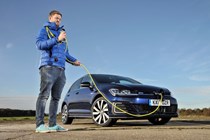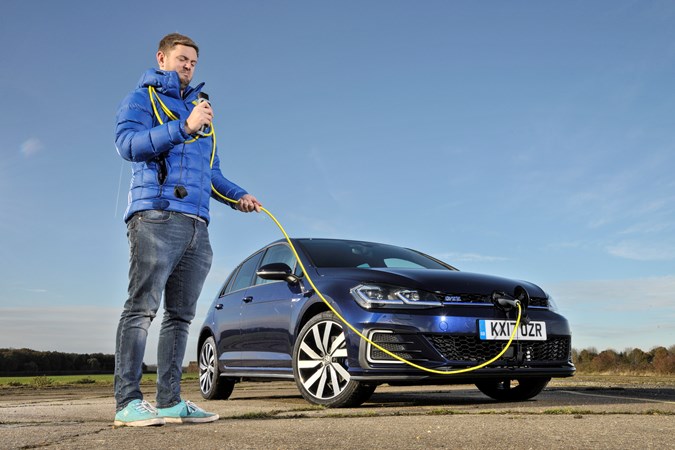
Update: The VW Golf GTE is currently not on sale, however, you can get an all electric version, which you can read about in our VW e-Golf long-term review.
Update 1: Welcome
A VW Golf GTE hybrid joins the Parkers fleet…

Let’s deal with some awkward opinions early on – I don’t like hybrids because they’re boring to drive, and I think a hot hatch powered by anything other than a massive petrol engine is a cop out.
You may think that makes me the worst person in the world to take ownership of a long term Golf GTE; a plug-in electric version of the iconic tartan-seated GTI that has come to define its genre.
But actually I’m exactly the type of person the GTE has been designed to convince. By 2040 all new cars sold in the UK will have some degree of electrification – cars like this will become the norm whether you like it or not.
So while the Toyota Prius was responsible for introducing hybrid technology to mainstream car buyers, the Golf GTE, with its bodykit and big wheels, is without doubt the car tasked with making it cool.
What the heck is a Golf GTE anyway?
First there was the iconic Golf GTI – a superbly judged balance between outright power and everyday usability – a sports car you could use on your commute.

Then the company car came along, and suddenly there was a market for something that looked like a GTI but produced less CO2. The diesel-powered GTD was born, which annoyed me very much (as explained above).
Fast forward to the present day and the diesel engine’s star is fading – sure it produces less CO2, but also pumps out harmful NOx gasses.
Simultaneously, technology was emerging that could make a small, low CO2-emitting petrol engine a viable alternative – namely better turbocharging, and electric motors driven by power-dense lithium-ion batteries. And so we arrive at the Golf GTE.
So it’s another GTI company car alternative?
If you want to be cynical then yes, it’s a low CO2, lower-NOx alternative to the Golf GTD you’ll see ploughing down the outside lane of the motorway every day at 8.30am.
It can be run on battery power alone for 31 miles of zero-tailpipe emission driving (says VW), or using a combination of electric and petrol power from the 1.4-litre, four cylinder combustion engine.
Best of all, there’s a special GTE mode which uses the most amount of power from both, giving you faux hot hatch thrills without the plummeting mpg figure that normally follows.
That sounds interesting…
It is – particularly the combination of a promised 156mpg, 40g/km of CO2 and 204hp – if you’re not bothered about the two former numbers then the latter means 0-62mph can be achieved in 7.6 seconds.
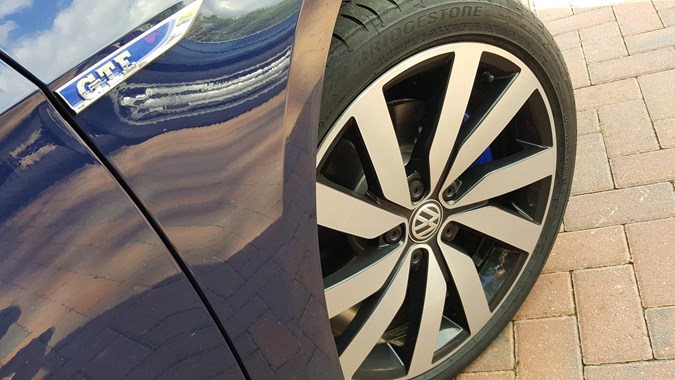
That’s a way off the pure-petrol GTI (this boasts a 6.2 seconds benchmark sprint) but it’s an admirable effort, plus 350Nm of torque means it feels stronger on the move than those figures suggest.
The biggest contributor to that smaller punch off the line is the GTE’s kerbweight – two powerplants and a slab of battery means this GTE weighs in at 1,615kg, some 300kg more than the GTI. That’ll no doubt affect the handling, which we’ll explore later on.
Is it as good as a GTI?
Only time will tell, we suspect. Being really sceptical, it feels like the GTE is really just an eco-focussed hybrid trading on the inherent coolness of the faster GTI, rather than a direct replacement.
That said, the fact there’s a market for a racier plug-in like this suggests there may be hope for petrol heads after all.
It certainly makes the GTE worthy of a proper investigation, not least to see if it can get under our skin the same way as a GTI.
By Adam Binnie
Update 2: GTE or GTE Advance?
We explore our GTE long termer’s engine and spec…

Unlike the standard Volkswagen Golf with its myriad engine and trim options, the GTE plug-in hybrid range is relatively easy to navigate.
There’s only one powertrain option – a 1.4-litre, four-cylinder turbocharged petrol engine combined with an electric motor and six-speed automatic gearbox.
This gives you a total of 204hp and 350Nm of torque, enough for a 0-62mph time of 7.6 seconds and a top speed of 138mph (or 81mph in all-electric mode).
That means there are two sources of fuel – a 40-litre petrol tank (that’s 15 litres less than a normal Golf) plus an 8.7kWh lithium-ion battery.
How long does it take to charge?
Depends – plug into a domestic socket and it’ll take 3 hours and 45 minutes, or 2 hours and 15 minutes if you have a special wallbox. The GTE comes with a different cable for each.
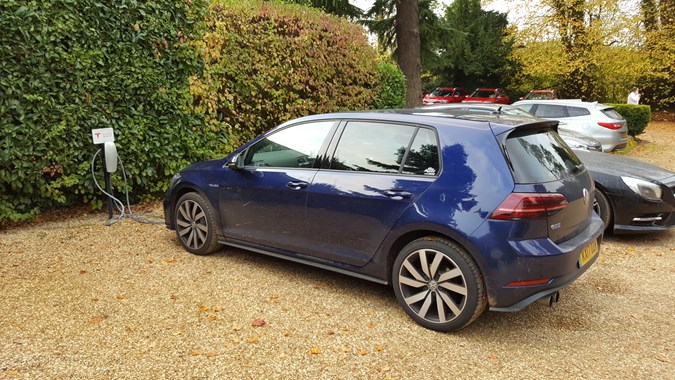
You’ll want to keep it fully charged if you want to get anywhere near the 156.9mpg and 40g/km of CO2 VW claims is possible. Either way, it’s VED and London Congestion Charge exempt.
The battery also boosts the Golf’s range and performance – you get a theoretical 31 miles on electricity alone or 514 miles combined. Without it the GTE is just a heavier version of the 1.4-litre Golf.
What trim levels are there?
The Golf GTE is five-door only and comes in GTE and GTE Advance trims – we’ve got the latter, which benefits from an uprated nav system, heated front seats, tinted rear windows and 18-inch wheels.
As well as all the usual safety kit like traction control and airbags, the Golf GTE Advance has an XDS electronic differential to help improve grip and handling, plus the following:
- Adaptive cruise control
- Autonomous emergency braking
- Automatic post-collision braking system
- E-sound exterior noise generator
- Front and rear parking sensors
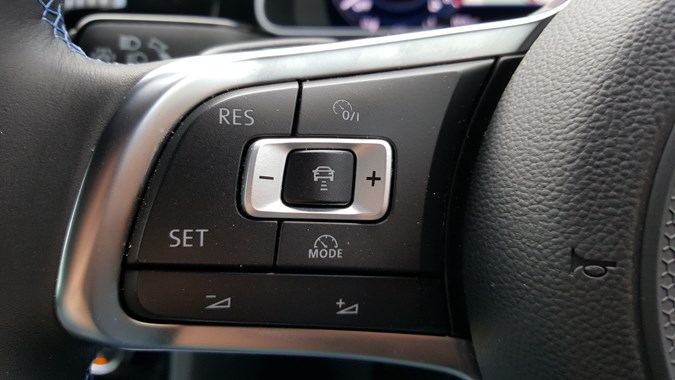
In terms of styling the GTE borrows its C-shaped LED daytime running lights from the e-Golf and aerodynamic fins from the GTI.
Like the latter, the GTE also has a host of coloured highlights, such as across the radiator grille and headlights, except they’re blue rather than red.
It’s the same story inside too, with blue stitching on the wheel, gear lever gaiter and seats, plus blue tartan-patterned sports seats. You also get:
- 18-inch alloys
- GTE styling pack (sporty front and rear bumpers, rear roof spoiler and side sills)
- LED headlights
- LED tinted rear light clusters
Both versions of the GTE get the 12.3-inch Active Info Display (digital dials) but the Advance benefits from the eight-inch Discover Navigation touchscreen infotainment system, plus:
- Two-zone climate control
- Electrically foldable door mirrors with puddle lights
- Heated windscreen washer jets
- Heated front seats

Finally there’s a host of connected tech under the VW Car-Net umbrella:
- Subscription to Car-Net Guide & Inform (traffic, fuel pricing, parking spaces etc) for three years
- Car-Net e-remote (remote battery charging management, departure times and pre-trip interior acclimatisation)
- Car-Net Security & Service (emergency/breakdown call service via integrated SIM-card)
What about options?
There’s plenty of choice here. We’ve selected the following:
- Atlantic Blue metallic paint (£570)
- Dynamic Chassis Control – choice of Sport or Comfort suspension (£830)
- Lane Assist, Dynamic Light Assist, Traffic Sign Recognition (£630)
- LED headlights (£310)
- Discover Navigation Pro (9.2-inch) with voice control, European mapping, Speed Limit Display, and gesture control (£1,325)
How much does a VW Golf GTE Advance cost?
That’s not so easy to answer – the base price is £32,135 but then you have to take away the Government’s £2,500 plug-in grant, leaving you with £29,635.
If you’re a company car driver the P11D value of £32,080 and 9% BiK band means a tax bill of £48 a month (if you’re on the 20% band).
Our car with options costs £35,810, or £33,310 after the plug-in grant. We’ll attack the various private financing options in a later update because this one already has far too many numbers in it.
By Adam Binnie
Update 3: Family car considerations
Does the GTE, with its smaller boot, work as a family car?

In this update Features Editor Sophie Knight and her husband, a lifelong Golf fan, put the GTE through its paces…
With a baby on the way, my husband Steve and I are considering which family car we should invest in – our little Ford Fiesta (three-door) probably won’t hack life with a newborn for long. So we were happy to try out the VW Golf GTE for the weekend.
For generations, the Golf has been seen as the ubiquitous family car – practical, reliable, with a fun edge if you go for a GTI. Steve has been a V-Dubber for many years so the Golf’s many benefits are well known. However, how would a hybrid suit our new lifestage?
In essence, we loved this car. It’s so easy to drive, really comfortable, with a smooth ride that coped with bumps (in the road, and mine) with aplomb.
Roomy Golf cabin
It’s really spacious on the inside; Steve is 6ft but found that sitting in the rear behind the driver’s seat in his driving position, he still had loads of legroom.
The traditional GTI tartan detail on the seats was attractive, and the blue lighting on the doors was impressive.
Having a hybrid appeals to my environmentally friendly attitude, and charging it up at home was pretty easy. The power from the battery meant the Golf’s acceleration was quick and nimble, and I happily left a 66-plate GTI eating my dust on one journey (much to their chagrin).
However, one major issue meant there’s no way we could consider this to be our new family car – the size of the boot. It’s just tiny. It’s barely any bigger than the boot on my current Fiesta.

It’s naturally taken up by the massive hybrid battery, but it meant that once our pushchair fitted in, there was barely enough room for just a couple of bags of shopping. A real shame.
But the only other negative I could find was that I kept accidentally pressing the cruise control button on the steering wheel instead of the volume button.
So, overall, we loved it. But the teeny tiny boot is a big problem.
By Sophie Knight – who achieved 62mpg!
Update 4: GTE or R Line?
What’s better, our hybrid, or a sporty conventional Golf R Line?
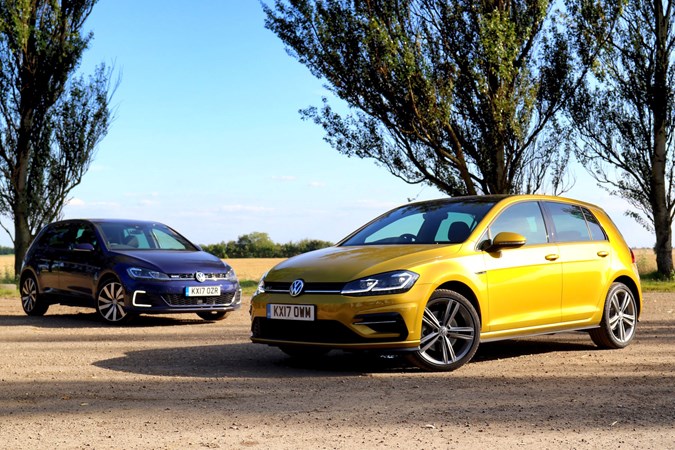
Many Golf models profit from the proper GTI’s hot hatch image – not just our GTE long termer, and the diesel-powered GTD.
Lower down the range there’s a sort-of-warm-hatch with sporty looks called the R Line, which borrows its badge from the range-topping Golf R.
It comes with variety of punchy engines, a lairy bodykit, and is available for quite a bit less cash than any of the cars mentioned above.
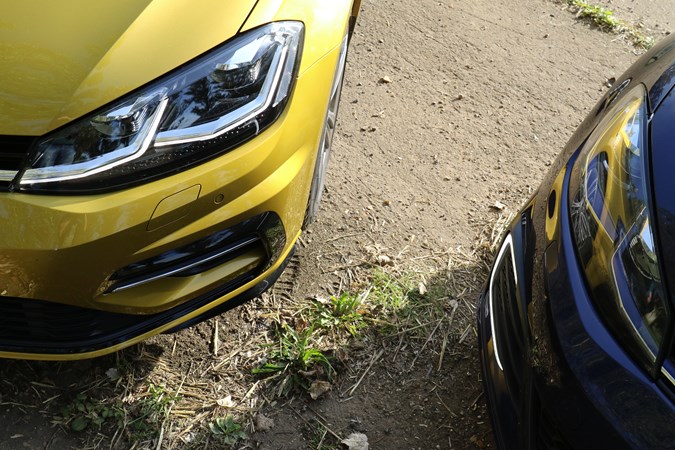
Thing is though, our GTE’s running costs are quite low and it comes comparatively better equipped from the off – so is the R Line a bit of a false economy?
How much does it cost?
On the face of it the less complicated petrol engined R Line costs a lot less than our long termer. Our GTE Advance comes with equipment like the Active Info screen, heated seats, parking sensors, adaptive cruise control, big wheels and an automatic gearbox for free though, so it’s not a direct comparison.
Adding those options to the R Line to make it equivalent bumps up the price, and then the Government’s £2,500 plug-in car grant, which our GTE qualifies for, narrows the gap further.
For business use the GTE’s lower CO2 (40g/km vs 114g/km) means it’s much cheaper – £37 a month in BIK tax vs £70 for the petrol R Line, if you’re a 20% tax payer.
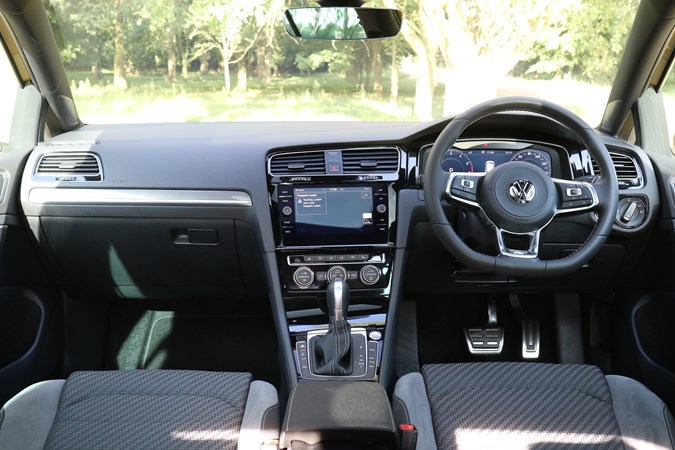
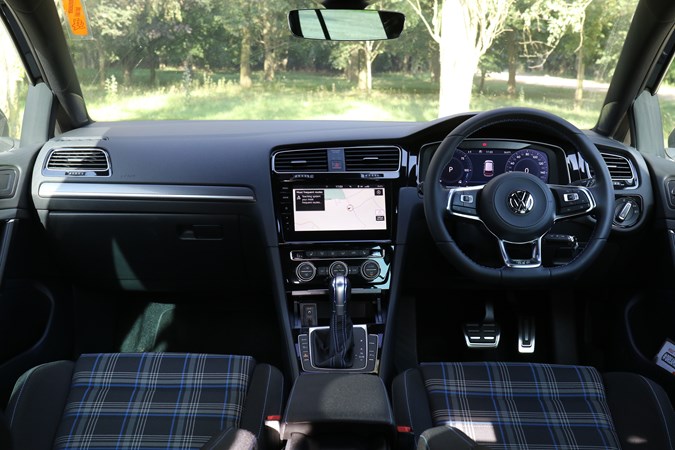
As a private motorist the R Line will cost you £4 a month less than a GTE Advance on PCP finance, but bear in mind that’s for a standard R Line, which isn’t as well equipped. That saving will be less once you’ve added all the extra kit, plus the GTE will cost you less per month to run.
How much less per month to run?
Well that’s the golden question isn’t it? And the answer is annoyingly vague, because it all depends on how you drive.
VW says you can get 156.9mpg from the GTE and 55.4mpg from the R Line – plainly both of those figures are a bit fanciful, but even if you take the modest 55mpg we’ve achieved in the GTE, and a conservative 45mpg for the R Line, our long termer will cost £20 less per month for a 12,000 mile a year driver.
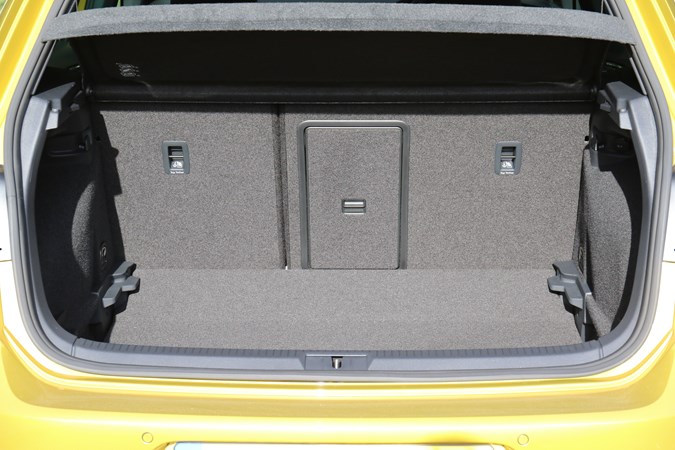
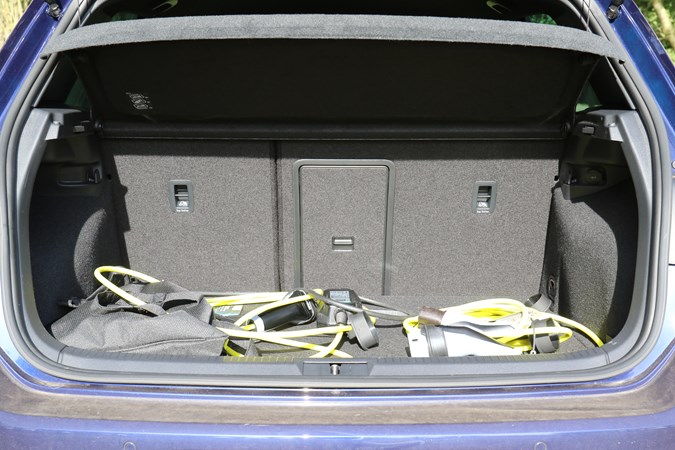
Of course you also have to take into account the extra price of electricity to keep the GTE’s battery topped up, and the more expensive tyres etc…
Are you going to tell me anything definitive?
Yes! In terms of power and acceleration the R Line is less impressive – 150hp and an 8.3 second 0-62mph time are eclipsed (although only slightly) by the GTE’s 204hp and 7.6 second sprint.
The R Line’s 1.5-litre petrol engine is actually the newer version of the 1.4 that powers our GTE. It’s a good unit, as it goes, but the GTE’s extra torque from its electric motor makes a big difference.
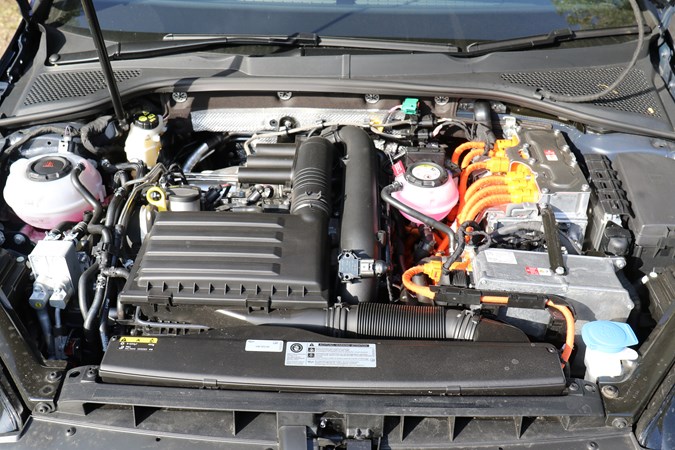
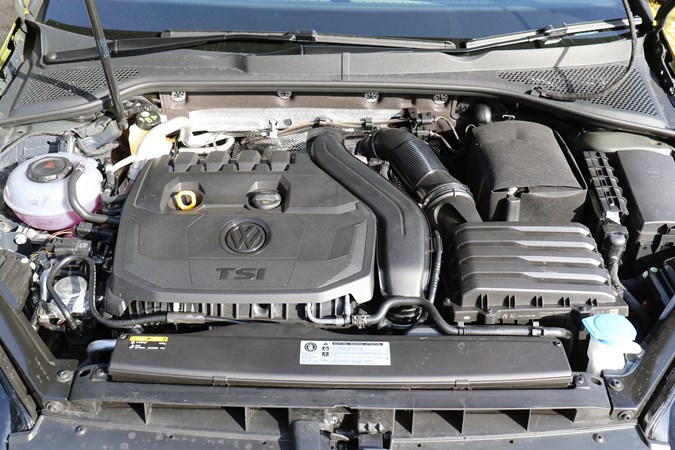
Our long termer looks considerably more exciting inside and out too. The R Line’s baby-Golf-R bodykit looks good, but the seats aren’t a patch on our tartan thrones.
Parkers Verdict
Annoyingly, there are too many variables here to come down one side or another – certainly as a company car we think the GTE makes more sense than the petrol R Line, but for a private motorist it’s less clear.
One thing’s for certain; this test has highlighted the excellent value for money you get with a GTE, thanks to all that extra kit and performance for relatively little outlay. Other Golfs are cheaper or faster, but few are as well rounded.
By Adam Binnie
Update 5: Plug-in to the Peak District
We test the GTE’s ability on a long cruise, and see how fun it is to drive in the Peak District…
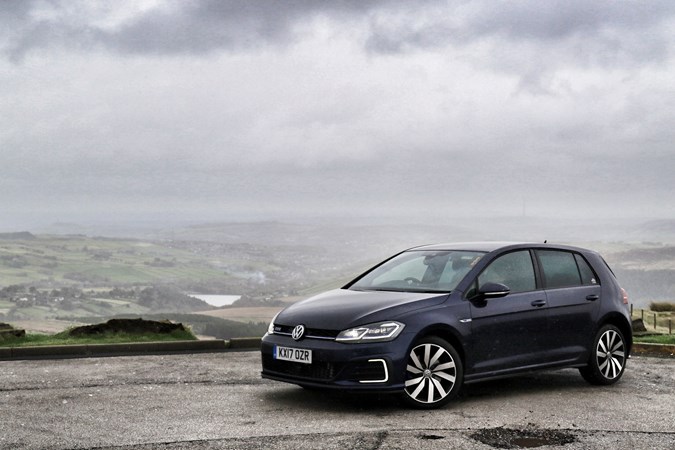
As well as conventionally-powered Golfs, Volkswagen also makes an entirely electric hatchback to challenge zero-tailpipe-emission rivals like the Renault Zoe and Nissan Leaf.
VW says it’ll do 186 miles on a charge, which is a fair shove further than our PHEV can muster on all-electric mode, and more than enough for a day’s urban driving. However, if you wanted to go to the Peak District for a drizzly weekend the battery (conversely) would be running pretty dry by the time you arrived.
That’d be a problem if, like me, you’d booked a BnB with no fast car-charger – because if you plug the e-Golf into a lowly three-pin socket you can reckon on waiting about 12 hours for a fill. No more driving for you.
So until the charging infrastructure catches up the Golf GTE is the best balance if you want clean electric power for town driving but an easily fillable petrol engine to stray further afield on the weekend.
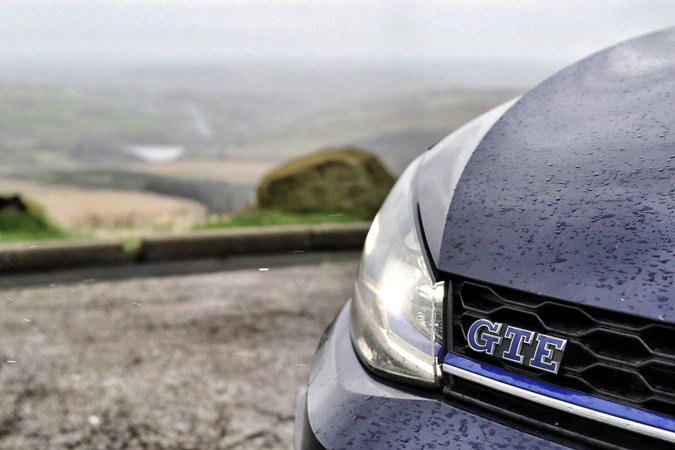
However, the long schelp on the M1 saw my fuel economy dip thanks to the fact the car was only using fossil-fuel only. My commute combines electric and petrol power and yields something between 50 and 70mpg depending on traffic.
Still, the GTE is supremely comfy on a long haul. The GTI seats are the best in the Golf range – supportive yet cushiony – while the ride with the optional adaptive dampers is composed and absorbent, and can be switched to a sportier mode if needs be.
I’ve got one gripe – the noise from those 19-inch wheels. VW fits Bridgestone Potenza tyres as standard and they’re fantastically grippy, but a quick search online suggests they’re quite loud in comparison with more economy focussed rubber. We’ll swap them for something with a lower rolling resistance in a couple of weeks and see what the difference is.
Still, the peaceful reservoirs of the Upper Derwent Valley are much quieter than the Golf (or any car really) and provide an almost limitless number of picture opportunities if you’re a talented landscape photographer (which I am not).

Luckily though, the location of our gentle stroll was right next to the Snake Pass – a road as wiggly as its name suggests – where I was hoping I could stretch the Golf’s legs a bit. As is often the way in the UK the road – although scenic and challenging – was absolutely packed with slow moving traffic including a mobile library, a lorry containing 20 head of cattle, and even a large piece of moveable artillery.
I’m exaggerating (although not much) but even so, there really wasn’t much fun to be had, so we peeled off and found another fantastically intestinal ribbon of tarmac near a place called Holme. Coincidentally there’s a town near Peterborough with the same name and a similarly good road, where the Parkers team does a lot of its photography.
Activating the Golf’s GTE mode gives you the maximum 204hp by combining both the petrol and electric motor at the same time rather than switching between the two as in hybrid mode.

You also get a much richer engine noise in the cabin, and in our car with its optional adaptive dampers the ride firms up as well. It also alters the gearbox logic to stop it holding onto gears at the top of the rev range like it does in hybrid mode.
To get the best from it however, you’ll want to use the paddles mounted on the back of the steering wheel – as even in this driver-focussed setting it still likes to change up into a high gear, which can get a bit annoying.
VW says the GTE’s performance rivals the GTI and while I don’t entirely agree, there’s certainly a lot to like about the way the hybrid car drives. It’s quite punchy thanks to all the extra electric torque and the latest hatchback chassis (called MQB by VW) feels neatly balanced and grippy.
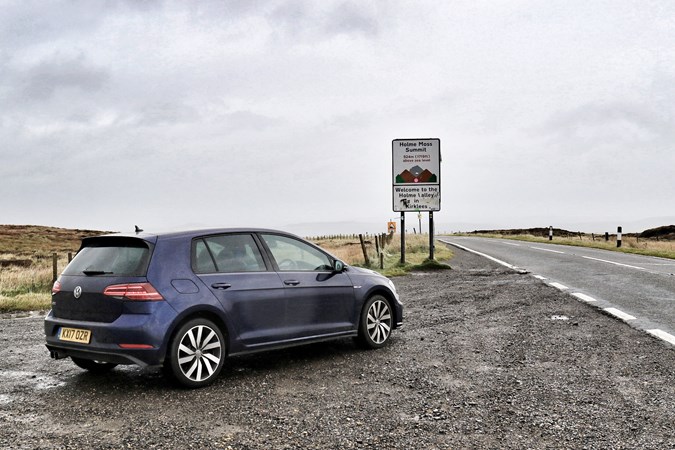
The main difference between our car and the proper hot hatchback is about 200kg of extra weight and a power deficit of nearly 40hp. That means it is slower and crucially that mass shows itself up in the bends, where the GTI feels lithe and agile, and the GTE less so. Fast cornering feels a bit like going for a jog after Christmas lunch.
Our biggest problem though remains the need to keep the battery full. If it goes flat while driving the GTE mode is much less exciting, so you have to stop and charge it, or use the petrol engine to top it up, wrecking the fuel economy.
To qualify that point, our average economy so far is 46mpg with highs of 62mpg – the tank spent in the Peaks yielded 38mpg.
Still better than what I’d expect from a GTI, but certainly less than I’ve been used to.
By Adam Binnie
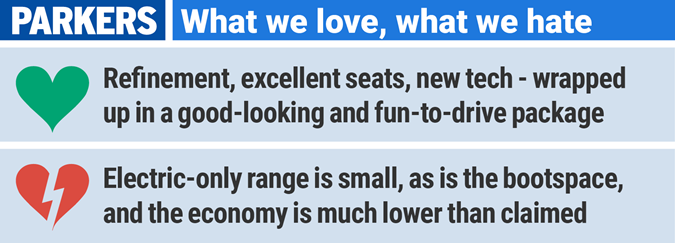
Update 6: A trip up north and a Golf R owner convinced
Can the GTE convert a Golf R driver? We take it to the Lake District to find out…

It’s nice to try the other cars on the Parkers team – and you find that some owners are less keen to hand over their keys than others. I often see that as a good sign – the less willing they are, the more they’ve bonded with their long-termer.
In the case of Adam and his Golf GTE, I actually began to think that getting him out of his car could have ended up with a gross act of bribery, but in the end, I sweet-talked him round, by offering to lend him my Skoda Superb in exchange for his GTE.
The intention of my weekend’s Golf ownership was educational. The GTE is riding on a wave of interest from drivers keen to move away from diesel, and who are attracted to the taxation benefits offered by this plug-in hybrid.
Can the Golf GTE seduce GTI, GTD and R owners?
As many of these potential GTE drivers are current owners of GTDs, GTIs or Rs, I thought it’d be a good idea to see if the PHEV version is as usable as those cars for long trips – in terms of fuel range, economy and drivability.
As per usual, I found myself heading for Cumbria on a Friday night. The drive from Parkers Towers is around 250 miles, and takes in mainly motorway and dual-carriageway A-roads, and probably represents a typical daily commute/job plan for the average professional driver. I
picked up the GTE fully brimmed with petrol, and charged up – and after I’d disconnected the cable and stored it in the boot (taking up more space in this already shrunken compartment), fired it up and headed north.
Time to head north to find out
Initial driving impressions are very positive indeed. You glide away in silence – the car defaults to starting in EV mode, therefore chewing through battery charge you might not want to use.
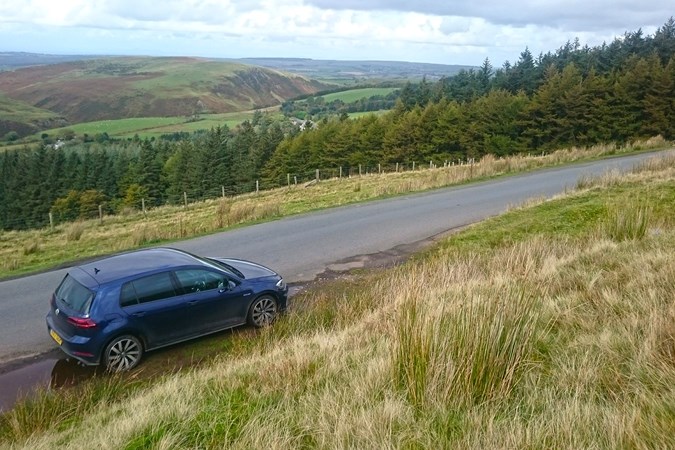
I’d been advised that the best mode to leave it in if you want to have fun is ‘GTE’, and I have to say that it feels responsive, quick, and thoroughly enjoyable like this. The 1.4-litre turbocharged petrol engine is supplemented nicely by the battery pack, which boosts acceleration very effectively. Like this, the GTE is a joy to drive.
Once on the A1 slog, I knocked it into standard hybrid mode and kicked back into the legal-limit cruise northwards. Motorway refinement is superb, and it feels very grown up indeed – easily a match for larger, grander, alternatives. By the time I’d reached our traditional half-way stopping point of Wetherby services,
The fuel was depleting faster than I thought it would
I was convinced I’d happily live with a GTE for the long run. Then glanced down at the fuel gauges – battery was down to 11 miles (from 31), and the petrol indicator had dropped down to the halfway point. Hmm. Must be a pessimistic gauge.
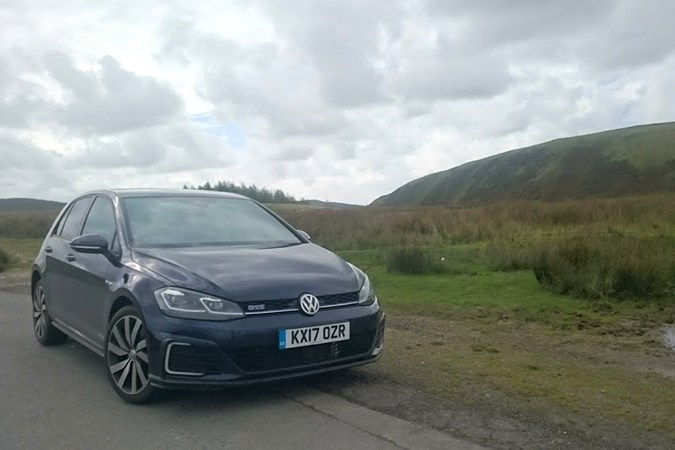
As the drive unfolded, I spent more time watching the petrol gauge, and was disappointed to find that this apparent lack of range was not an illusion. As I rolled to within 10 miles of my destination, the fuel warning bonged – I was on reserve fuel!
After 10pm most of Cumbria closes and goes to bed, so getting fuel wasn’t going to be easy – so instead I headed for home, hoped for the best, and braced for the worst. Anxiety building with each passing mile, I made it home with literally 10 miles of petrol left in it, and no more electricity. Not useful for a car that’s being targeted at professional drivers.
Arriving home on fumes. Oops!
The next day, and after a fill-up from my local Shell station, I checked the fuel consumption figure. Bearing in mind it was in GTE mode for the entire time, and I’d not been driving for economy, I was figuring it wouldn’t be great – but the 33.6mpg was seriously unimpressive.

I guess my 250-mile drive to the hills isn’t actually what this car is best suited to, but to put it into perspective, my 280hp Skoda Superb estate would easily beat that on the same run.
Still, the trip wasn’t all about that. The excellent long-distance refinement, and ability to deliver more B-road smiles than, say, the Toyota C-HR are heartening.
Would you swap a Golf R for a GTE?
The other purpose of the trip was to see whether the PHEV would appeal to an existing Golf owner looking to trade into something greener and more economical. Handing the car over to a 16-plate Volkswagen Golf R-driving neighbour Tony Calvin who’s looking to replace his car with something more economical on his 10-mile commute was going to very interesting.
He’d mentioned a Golf GTD, but has some long-term concerns about diesel. The GTE should fit him like a glove, then. As he drove away, he put his foot down (in GTE mode of course), and I could see he was impressed (despite his own car being able to do 0-62mph in 4.6 seconds).
He liked the way it pulled away silently, the electronic dashboard, and the way it drove overall.
Commuting for ‘free’ a winning argument
Additionally, when I explained that if left plugged in at night in his garage, he’d be able to drive to work and back every day on battery alone, he smiled widely. ‘Would you buy the GTE to replace your Golf R?’ I asked.
Without a pause, he replied, ‘yes – for my commute, this will be absolutely perfect. It doesn’t feel that much slower than my R, and the boot space is pretty much the same.’ Is Tony sold on moving to a hybrid, I asked? ‘You bet,’ he answered. ‘It appeals to me, and would fit perfectly into my life.
‘The under-bonnet view is pretty scary, though, and my Golf R hasn’t been that reliable – so I need to see how reliable they are in the long run before taking the plunge.’
Looks like another potential diesel owner could be moving to PHEV instead. Let’s hope he’s not too many long trips planned and doesn’t mind the short cruising range…
By Keith Adams
Update 7: Better than a GTD?
We try to convert someone about to order a diesel Golf company car…

As I’ve alluded to previously, the GTE is considerably cheaper than the GTD, whether as a company car or on PCP finance.
In the case of the former, our GTE Advance has a higher P11D price than most Golfs but the 40g/km official CO2 rating means it’s cheaper than almost all others to tax – save for the standard GTE and the all-electric e-Golf.
In fact you can expect monthly tax bills of £48.12 for the GTE instead of £121.17* for a five-door automatic GTD, with broadly similar performance and equipment.
Finance it yourself and the story’s the same – VW’s PCP calculator suggests that our car would cost £293 per month, compared to a similar GTD’s £373 figure (on a 48-month contract with a £3,000 deposit and 10,000-mile-per-year allowance).**
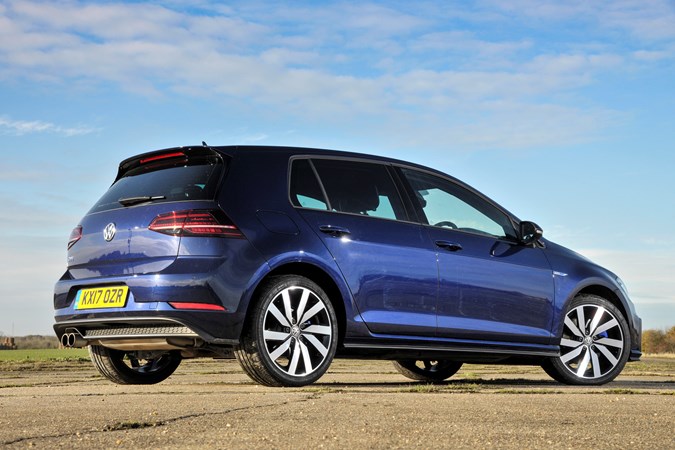
The thing is, there’s not much point saving money on a car you can’t stand driving, so when the Managing Director of our magazine group’s motorcycling titles Rob Aherne mentioned he was in the market for a GTD as a replacement for his BMW 330d, we decided he was just the kind of test driver we needed to recruit. Here are his thoughts:
I’d never considered a hybrid before – my previous experience was confined to Toyota, Lexus and Honda products, all of which made me feel I was wearing a hairshirt somehow.
This, however, is a very enticing package because the tech is so well integrated. I’ve already started tailoring my driving towards efficiency rather than lazily lumping my foot on the throttle, but that’s actually a lot more fun than it sounds: the car glides along so effortlessly in e-mode that you want to keep it there for as long as possible.
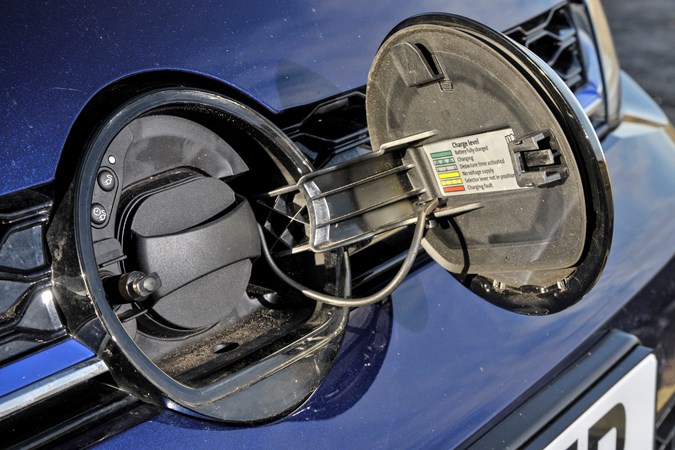
My commute is well within the electric range but I’ve discovered the car won’t stretch to do both ways without using petrol, mainly because about 12 miles are generally completed at 70mph or so. One night I drained 20 miles from the battery because I drove as I ‘normally’ would, on clear-ish roads.
When the schools are back, and there are thus more jams, it might be different, but I will take the view that it’s a journey to do in hybrid mode and enjoy 50-55mpg rather than trying to eke the charge out. Economy is still comparable to a diesel and you do feel like you’re beating the system by running errands without touching the petrol engine.
I think that big touchscreen in the Advance model really adds to the car’s appeal, as well as being more practical than the standard item. I think the interior is terrific for a £30k car – it knocks spots off my 330d, which is £10k more, but it misses something in the form of keyless entry and go.
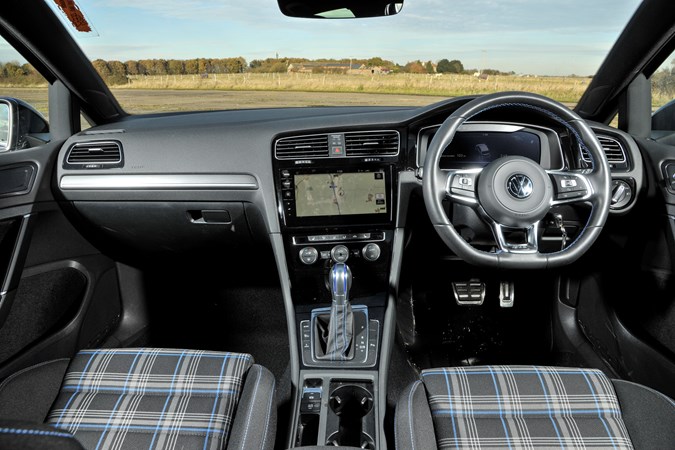
You are also very much aware of tyre noise on some surfaces. Although I don’t have a particularly wide frame of reference beyond my 3 Series and our family Ford S-Max, the VW is conspicuously noisier than both.
The GTE button is a nice marketing gimmick but isn’t all that in practice. This car patently isn’t a GTI and pressing on is much less fun than you’d expect of any car with sporting pretensions. I don’t think it stands up to being called an ‘electric hot hatch’ and anybody looking for one should go elsewhere.
Most impressive for me is that it feels just like a Golf for the most part, which is very positive. I haven’t had the chance to test the reduced boot capacity yet, but my particular need is for four seats and four doors for the school run rather than load lugging.
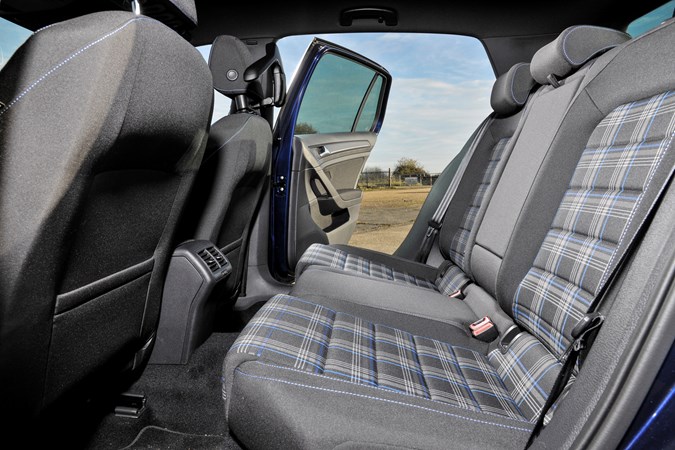
With that in mind the GTE suits me pretty well and makes the GTD feel a bit low-tech and old-hat. Leasing one for two years is a bit of a gamble, as my family lives further afield and I do go there every month or so: the GTD would definitely be better for that journey, and might be more useful generally on the A1.
But overall I’m banking on having much cheaper fuel bills and a more ‘interesting’ car day to day than a GTD – leasing costs are pretty similar between those two and the GTI, incidentally.
The conclusion? Rob’s got a GTE on order.
By Adam Binnie and Rob Aherne
*Guide figures from VW for a 20% tax payer based on 2017/18 rates
**Quote obtained in November 2017, based on a 48-month deal, £3,000 deposit, and 10,000-mile-per-year allowance. Everyone’s financial circumstances are different and credit is not always available – Parkers cannot recommend a deal for you specifically. These deals are indicative examples of some packages available this week.
Update 8: Tyred of road noise
Can some Michelin tyres quieten the GTE’s noisy cabin?

One unanimous complaint I keep hearing from people who drive my Golf GTE long termer is how noisy the cabin is, even when driving in all-electric mode.
The tyres are the culprit, transmitting a dull rumble into the car even at low speed. VW fits performance-focussed Bridgestone Potenza rubber to the GTE, which fits the hot hatch side of this car’s personality, rather than the quietly efficient plug-in hybrid character.
Thing is, the GTE’s dynamic shortcomings (discussed below) have nothing to do with the amount of grip offered up by the tyres, so in theory we could happily swap them for something quieter and suffer no ill handling consequence, and potentially reap better fuel economy too.
Fitting Michelin CrossClimate+ tyres to the VW Golf GTE
This test also coincides with the arrival of winter so while we’re swapping out the Bridgestone summer tyres it makes sense to pick something a bit more all-weather ready.

Most UK motorists drive on summer tyres all year round, whereas it’s common in colder European countries to swap to a set of proper winter tyres when the temperature drops – in fact in places like Germany and Finland it’s a legal requirement.
Winter tyres generally don’t work as well as summer tyres in dry conditions though so it’s important to swap them back again come the spring, which is a bit of a pain and perhaps why we don’t bother here in the UK.
Michelin reckons it’s solved the problem with its CrossClimate+ tyres – technically a summer model, these use a special compound and structure that also makes them dead useful in the winter. So much so in fact, you can use them as full-blown winter tyres in the countries mentioned above.
What are these tyres like?
The rating sticker claims they are more efficient than the Bridgestones and quieter to the tune of three decibels. They’re also about £30 a corner more expensive, so that’s a consideration.
At the risk of sounding dramatic, the GTE has been transformed by the new rubber. It’s so much quieter on the move. So much so that you can now hear various chirps and whistles from the turbo, and the noise of the regenerative braking system, plus the slight whistle of wind noise rippling off the door mirrors.
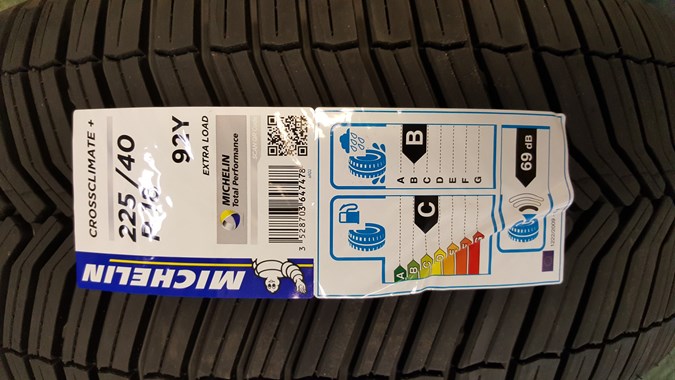
It’s curiously more fun to drive now too, offering a bit more driver involvement over the glued-to-the-road Bridgestones. And although we’ve only put four tanks of fuel in it so far, the economy is better by 7mpg. Michelin says the tyres won’t be at their most efficient straight away, so in theory this should improve.
What about the winter performance?
Luckily (or not) only two weeks after we swapped over it absolutely hammered it down with snow, giving us the perfect opportunity to test them out on some country roads near the office.
Without driving the Golf back-to-back on the old tyres and new, it’s hard to be scientific, but what I can say is it felt very confident indeed even in several inches of snow. It pulled away cleanly, braked well and the front end bit into turns regardless of whether there was any visible tarmac.
At one point we encountered a motorist at the bottom of a hill in an all-wheel drive equipped saloon (shan’t say which make) on summer tyres who said he’d made several attempts to reach the summit but had given up after sliding back down every time. The Golf made it up with no drama at all, aside from a bit of tramlining in some snow ruts, but that had nothing to do with the tyres.
So you’d recommend them then?
Certainly from the short test of both sets of tyres I’d say it’s worth swapping from the supplied rubber.
The Bridgestones may have got quieter after a few more thousand miles, and I reckon some even more economy-biased tyres would be better still, but given the CrossClimate’s winter performance, they’re a great all-rounder at this time of year.
By Adam Binnie
Update 10: Better than an Audi A3 E-tron?
GTE faces off against Audi equivalent
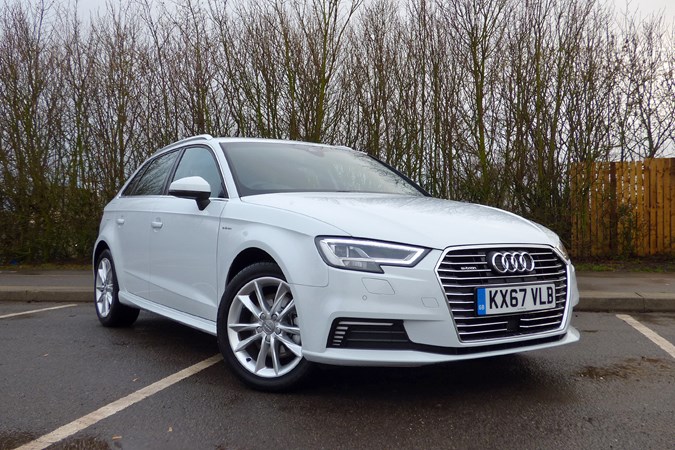
If you want a plug-in hybrid hatchback without the sporty looks of our GTE there’s a luxurious alternative in the form of Audi’s A3 e-tron.
It’s basically the same car, with an identical 1.4-litre petrol engine and electric motor drivetrain, but with different styling and equipment.
That means an identical 204hp and 350Nm of torque, translating into equal 0-62mph times of 7.6 seconds and a top speed of 138mph.
Are the differences more than skin deep?
The biggest variance (no surprises here) is price – our Golf GTE is £32,135 vs the £36,040 Audi will charge you for an e-tron. It’s much cheaper on finance as a result.
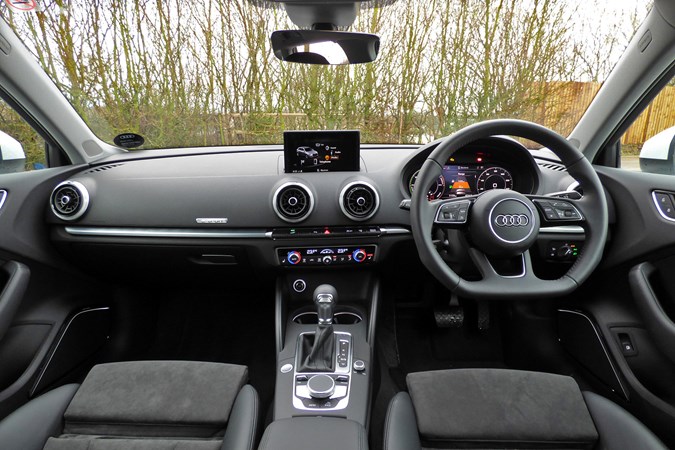
There are no fundamental differences in specification, merely a few minor kit differences:
| Golf | A3 | |
| Wheels | 18-inch | 17-inch |
| Tech | Active info display | Lane assist, keyless |
| Practicality | No roof rails | Roof rails |
We don’t think there’s enough there to justify the extra cost, quite frankly, unless the Audi badge means that much to you.
Do they drive the same?
You’ll have to ask Lawrence Cheung, the Parkers details man, because I was laid up in bed with a terrible ailment (probably a cold) when the e-tron was here.
He said: ‘The A3 has a softer ride quality but the Golf has better damping, meaning it’s arguably better controlled. I don’t like the brake pedal modulation either: it’s all or nothing.
‘The Golf GTE also feels more special – being a more purposeful model sitting higher up in the range.
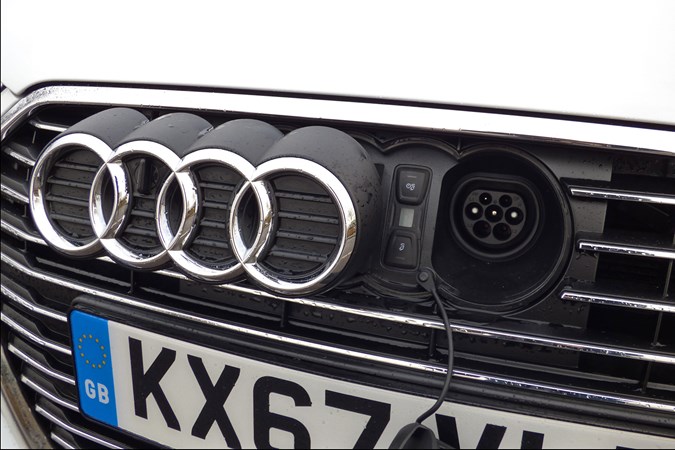
‘The e-tron blends into the A3 range and doesn’t feel special enough – great if you’re looking for a ninja-type EV where no one notices in the looks department. Not so great considering the price.’
Verdict
It’s not looking great for the Audi, but it does have one rather large advantage over the Golf GTE.
Sales for VW’s hybrid hatch are currently on hiatus thanks to a huge spike in demand, but for now at least you can actually go out and buy an A3 e-tron.
We reckon that’s largely because the Golf is the better all-rounder and far cheaper; lacking the Audi’s badge appeal but making up for it in terms of value, styling and the kit of offer.
By Adam Binnie and Lawrence Cheung
Read our next update
Update 9: Best performance Golf?
GTE tested against hot rivals the GTI and GTD
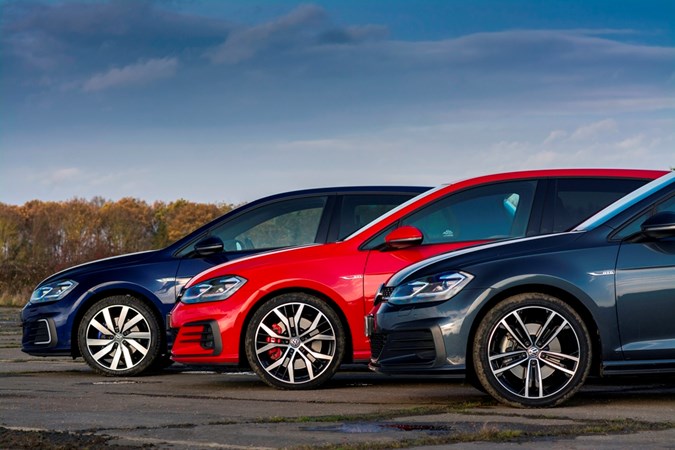
We began this long term update by asking whether the VW Golf GTE was a proper hot hatch like its GTI and GTD namesakes – now we’re going to answer it.
By Adam Binnie
Read our next update
Update 10: Bargain Bucket (seat)
We raid the VW accessories catalogue…
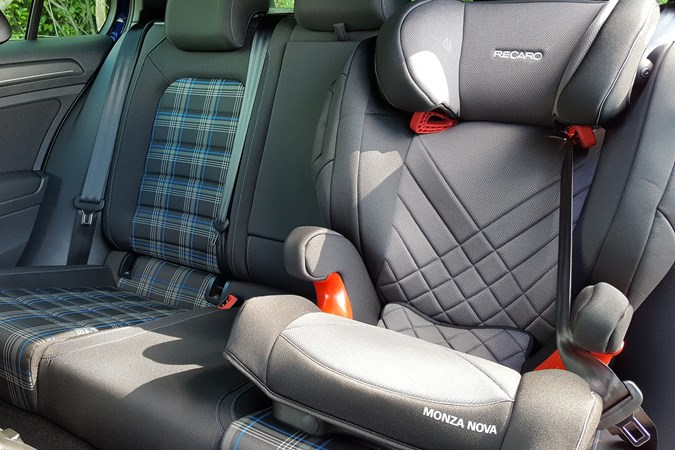
The trouble with the iconic tartan-patterned seats in our Golf GTE long termer is that they make my son’s plain black Isofix chair look extremely dull.
Luckily when you come to order your Golf, VW will happily sell you a much racier-looking child-size bucket seat to match the GTE’s performance styling. And you can just add it to your monthly finance bill and forget about it.
There are several in the VW accessories catalogue to choose from and we went for a Recaro Monza Nova 2 for reasons that will become abundantly clear.
My First Recaro
This is a group two to three Isofix, which means it’s forward facing only and doesn’t have an integral harness, so is suitable for 3- to 12-year-old children weighing between 15 and 36kg.

Importantly though, it says ‘Recaro’ on it in bold lettering, which for someone who grew up around 1990s hot hatches means it’s already off to a winning start.
It’s a cool-looking thing thanks to almost Bentley-like levels of diamond quilting and bright red guides to show you where the seatbelt threads through. And like I said, it’s got Recaro written on it.
Tell me more about its features
The two Isofix legs are spring loaded and pop out with some ferocity. They are easy to guide into position, largely thanks to their length and the plastic tunnels in the Golf’s rear seats, which act like a portal to the Isofix mounts. I’ve come to view these as an essential accessory now.
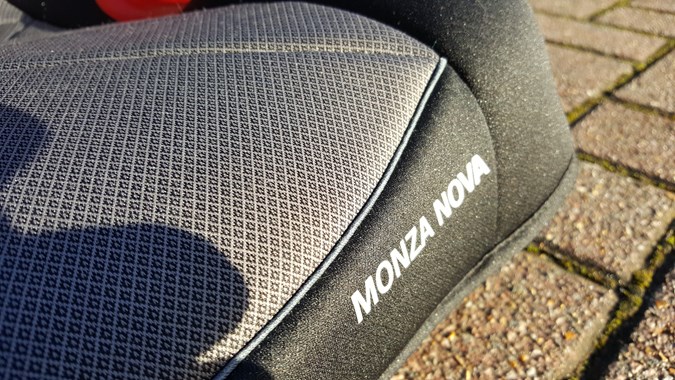
It’s got loads of side protection (so much so that it renders the middle seat absolutely unusable) and a headrest with inflatable cushion for extra comfort. There’s even an integrated sound system with a headphone wire that runs up the back of the seat into some speakers so you can blast drum and bass at your toddler.
I didn’t use this much, but one member of the Parkers team who will remain nameless found it very exciting indeed, despite not having any kids, and insisted on ‘the boombox seat’ remaining in the Golf whenever they took it for the weekend. I decided it was best not to ask.
What’s that handle thing for?
Good question – and one I was often asked by rear seat occupants. It’s not, as I often suggested a grab-handle for terrified passengers, but actually somewhere to hang your coat.
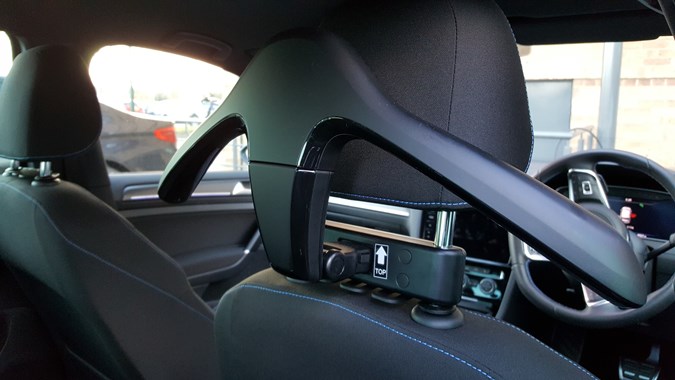
Turns out it’s a bit of a throwback to when we first ordered this car and one of my learned colleagues had the intention of stowing a suit jacket on it. This is a company car special, and people who drive company cars need somewhere to hang a blazer. Maybe.
It’s not a gadget I’d ever encountered before but it’s a superb thing for drying off a waterproof coat following a drizzly hike somewhere on the weekend. The kind you take a toddler on when they’re climbing up the walls at home.
Failing that I suppose you could encourage younger members of the family to let off some steam by doing some chin-ups on it.
By Adam Binnie
Update 11: Farewell
We wave goodbye to the GTE, but are we sad to see it go?
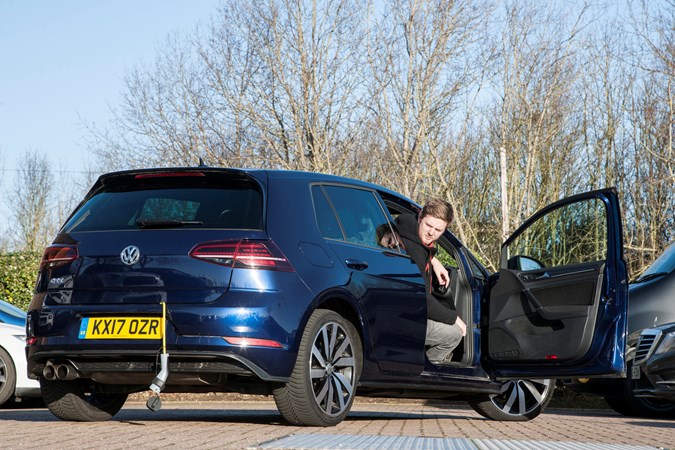
You may remember at the beginning of this long-term review that we set out to discover whether the hybrid VW Golf GTE was a viable replacement for the diesel GTD, or petrol GTI.
After six months and nearly 10,000 miles I’m happy to say I can definitively answer that.
The Golf GTE is in many ways a more attractive offering than a GTD, but not quite exciting enough to prise me out of a GTI.
That doesn’t sound definitive to me…
Well yes. And the problem here is the same with any plug-in hybrid; the Golf GTE is an excellent car, providing your lifestyle supports it and, vitally, you keep it charged.

During our time with the Golf I like to think that we treated it like a fairly normal owner – charging it less frequently than it would have liked, while using the GTE button perhaps a bit too readily.
As a result we averaged 46mpg during our time with it and spent £1,030 on fuel, working out as 8.8p per mile.
Wouldn’t a GTD be more efficient?
Probably, but that’s where the lifestyle bit comes in. Disregard the times we drove the Golf to the Lake District or Cotswolds and that figure improves to 51mpg, thanks to the high proportion of fully-charged commuter-miles the GTE thrives on.

Better yet was the weekend that Features Editor Sophie Knight took the Golf, dutifully keeping it charged and only driving short journeys – resulting in an efficiency high-water mark of 63mpg.
The worst tank of fuel was recorded in the Peak District, where our repeated use of the GTE button and the need to charge the car’s battery from the engine meant we saw an eye-watering 33mpg.
Not a particularly convincing hot hatch then…
The GTE certainly had its moments, and the battery-boosted acceleration would catch faster cars out at times, but on the whole it was a bit too heavy and laboured in its movements to thrill like a GTI.

Get it on a good road and the electrical charge would soon wane, leaving you with essentially a heavier 1.4-litre petrol Golf, where a GTD would simply keep going. You can recharge it with the combustion engine, but then you’ll get 33mpg.
Finally, without meaning to damn it with faint praise, the GTE was just more fun to drive efficiently, eking out the best economy from the hybrid powertrain while wafting around in silent-running electrical refinement. Once we swapped the noisy tyres out, of course.
This also had the advantage of making it almost invincible in the snow – a huge surprise, and an impressive effort.
Why pitch it as a GTE at all?
Audi uses this drivetrain in the A3 and refers to it simply as the E-Tron, rather than giving it a sporty persona like VW. We drove them back-to-back and found the A3 more boring to look at and steer, oddly enough.

As I said in our video update – the Golf GTE isn’t a hybrid hot hatch, but it is a fun hybrid, and that’s a good thing. This is a PHEV that doesn’t feel like it’s punishing you for chasing good economy.
Given that this car is still a bit of an opening gambit from VW in the sphere of sporty hybrids, we reckon there’s only good things to come.
Any other gripes?
The boot was quite compromised compared with a standard Golf thanks to the relocation of the petrol tank, and you have to press a button on the driver’s door to open the filler flap, unlike any other Golf, which was a bit annoying.
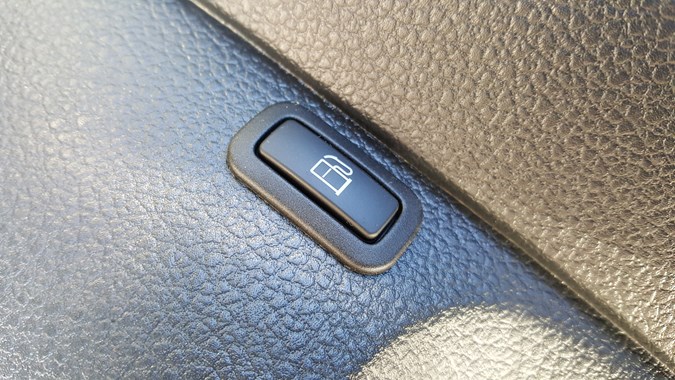
A problem shared with all plug-ins is the length of the cable you’re given (always too short) and the fact this further eats up boot space, plus it’s usually wet or covered in mud. I’ve always thought it should coil up under the bonnet and extend out like a Henry vacuum cleaner.
Other than that the GTE in Advance trim like ours is a really lovely thing, with solid fixtures, ergonomics set by years of whittling, plus clear and bright sat-nav/Active Info displays.
The Parkers Verdict
In the real world a GTD would be much more flexible and deliver a solid mile-per-gallon figure time after time, free from the economy tightrope that the GTE walks. A GTI would also be markedly more fun to drive both in terms of its vivid straight-line performance and light-footed cornering ability.

Thing is though, as a company car driver you can run a GTE for buttons, and even as a private motorist, the PCP finance deals are attractively cheap enough to make you think twice. I for one really miss its soothing nature and exciting-for-a-Golf looks.
By way of conclusion consider this – at the time of writing, the GTE order book was still firmly shut due to unprecedented demand, as had been the case for about half the time we ran our long-termer.
Of course I’m not suggesting that popularity has anything to do with the quality of our stellar updates – but it does make you wonder.
By Adam Binnie
Just so you know, we may receive a commission or other compensation from the links on this website - read why you should trust us.



